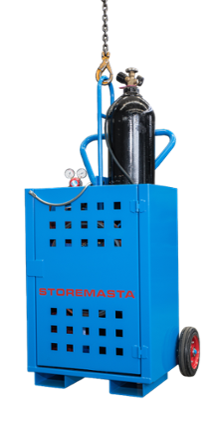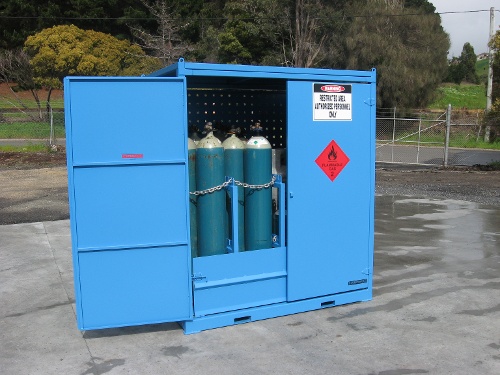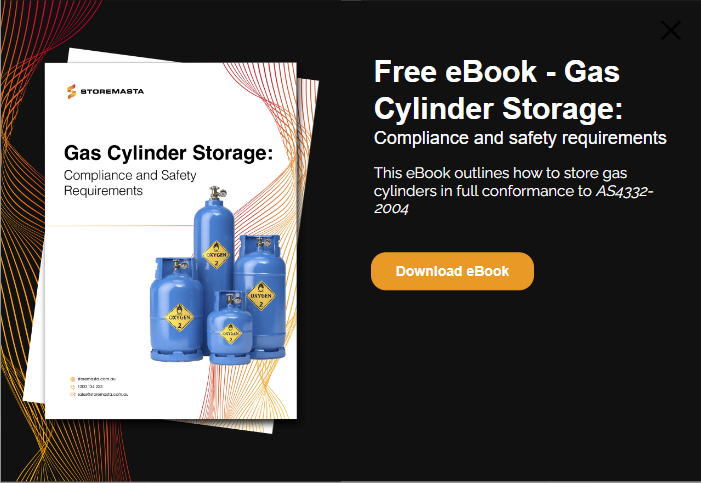Knowing how to store and handle gas bottles properly is so important for the safety of your staff and organisation. Gas bottle safety includes vigilant handling, storage and maintenance to ensure there are no physical or physiochemical hazards when working with gas cylinders or gas bottles.
Gas cylinders should be retested and stamped every 10 years, with dented, damaged or corroded gas cylinders tested again to ensure safety. Heat and ignition sources, such as naked flames, must always be kept away from these dangerous goods. Strict controls and procedures need to be put in place to make sure your team are protected when working with these cylinders.
In this post, we share our 5 best tips for gas bottle safety in the workplace, so you can stay safe and comply with WHS legislation.
TIP: For more information about storing and handling gas cylinders safely at work, download our free eBook Gas Cylinder Storage: compliance and safety requirements.
1. Restrain Cylinders
Most gas cylinders have long, slim designs and can easily fall or be knocked over. You must ensure that gas bottles are always upright and restrained with straps or chains just above the cylinder’s midpoint — and tight enough so they can’t slip off.
 There are a range of gas bottle trolleys to assist with the safe transport of cylinders around the worksite, like our Storemasta Oxy Acetylene Trolley.
There are a range of gas bottle trolleys to assist with the safe transport of cylinders around the worksite, like our Storemasta Oxy Acetylene Trolley.
Unloading and transfer
Cylinders should always be unloaded or transferred using gas cylinder handling equipment. Gas cylinders can be moved with mechanical lifting devices (eg, forklifts) or gas bottle trolleys that keep the cylinder upright and securely restrained.
Using gas cylinder handling equipment also prevents workers from:
- Lifting or carrying cylinders by the valve or cap
- Dropping or throwing cylinders from trucks
- Rolling cylinders along the ground.
- Handling and usage
When in use, cylinders should be secured on a gas bottle trolley that has hose hook, ratchet strap, and enclosed sides. Maintenance and welding work should be done so that cylinders are protected from possible impact from vehicles and falling objects.
REMEMBER: Compressed gases can easily leak when they are being used or transported. If you need to transport gas bottles in a vehicle or around your worksite, you should avoid doing so in an enclosed vehicle as the gases could accumulate and create a hazard.
Storage
When gas cylinders aren’t being used, they should be stored securely in a gas bottle cage. Each cylinder should be stored upright and individually restrained with a safety strap or chain. Make sure your gas bottle or cylinder storage offers adequate ventilation to avoid physical, chemical or physiochemical hazards, such as fire or asphyxiation due to escaped gases.
Gas cylinder storage, like our Industrial Gas Cage, should meet the requirements of the Australian Standard.
Gas cylinder valves should be closed, and attachments or gas appliances disconnected then removed. Cylinders should also have safety caps in place.
IMPORTANT: A suitable trolley or lifting device shall be used for moving cylinders in an upright manner, with the cylinders securely restrained, and in a manner that cannot cause damage to the valve. Section 5.2.1 (o)(ii) AS 4332.
2. Segregate Gases From Incompatible Substances
Compressed gases are classed as hazardous chemicals and must be segregated according to their hazard classification and kept away from incompatible substances.
According to the Australian Standard, the gases listed below (flammable, toxic and oxidising gases) must be segregated from each other by at least 3 metres. However, refer to your own risk assessment to determine the proper segregation guidelines for your gases and dangerous goods.
Generally speaking, the following segregation rules apply to your gas cylinder stores - each division of gas must be separated from the other division by a suitable distance (at least 3 metres). Keep in mind though, your own risk of fire, and the quantities of gas that you hold on site.
Separate these divisions always:
- Class 2.1 flammable gases (acetylene or LPG cylinders)
- Class 2.2 (5.1) non-flammable, oxidizing gases (oxygen gas cylinders)
- Class 2.3 toxic gases (chlorine gas cylinders)
The segregation can also be achieved by installing a non-combustible wall at least 1 metre higher than the tallest cylinder. The wall must be impervious to gas vapours. Refer to the Australian Standard for specifics.
IMPORTANT: Areas in which cylinders are kept shall be clear of combustible materials, vegetation and refuse, for a distance of not less than 3 metres from any cylinder. Section 5.2.1 (d) ii) AS 4332.
3. Treat Empty Gas Cylinders As If They Were Full
Empty cylinders still contain residual gas and are vulnerable to ruptures and gas leaks. They must be treated in exactly the same way as if they were full.
Make sure your empties are labeled correctly and separated from full cylinders. Empty cylinders must also be segregated according to their hazard class.
You must store empty cylinders in a compliant gas cage, to ensure they don’t pose risk to your organisation.
IMPORTANT: All cylinders are regarded as full unless gas-freed by the manufacturer or not containing a valve. Section 1.1 AS 4332.
Listen to the Chemical Safety at Work podcast or follow our Youtube channel to learn more about 'empty' cylinders and chemical containers.
4. Keep Gas Bottles and Gas Cylinders Secure
Gas cylinders have a dangerous history of involvement in skylarking and pranks (particularly by new workers and young people). AS 4332 - The storage and handling of gases in cylinders requires that gas bottle cages are fenced and otherwise secured to prevent untrained and unauthorised people accessing cylinders. Gases stored in the lab can be particularly vulnerable.
Apart from the examples listed below, untrained staff or contractors who don’t understand the full dangers of the gases stored onsite, may inadvertently use or handle a cylinder incorrectly. This could lead to their own death from asphyxiation, exposure to toxic and corrosive gases, or a catastrophic fire and explosion.
Below is a table of examples of how hazardous gases may be misused.
|
Example of how hazardous gases are misused |
||
|
Helium |
Inhaling gas to make your voice sound funny. |
Despite being depicted as cool on TV and in movies, inhaling helium displaces oxygen in the lungs the same way as drowning. It’s very easy to die from asphyxiation. |
|
O2 |
Pure oxygen intended for medicinal use and first aid, is often misused as a ‘hangover cure’. |
Apart form oxygen toxicity, breathing pure oxygen under pressure can cause lung damage. Pure O2 is extremely flammable and misuse could also cause fires/explosions. |
|
N2O (Laughing Gas) |
Laughing gas is often misappropriated and used as a recreational drug. |
Nitrous oxide is an anaesthetic gas that is addictive and habit forming. Breathing N2O can cause immediate asphyxiation or impair workers, rendering them unable to safely perform their duties in the workplace. |
|
Misusing cylinders |
Dispensing gas to propel things. |
The sudden release of any gas under pressure can easily kill a person. |
IMPORTANT: Cylinders shall not be used for any purposes other than those for which they were designed. Section 5.2.1 (f) AS 4332
5. Use Correct Signage for Gas Bottles
Make sure your gas cylinder stores have compliant and clear signage, including mandatory placards. Gases of different hazard classifications will each require a different dangerous goods label.
Required warning signs and placards for stores holding gas cylinders include:
- A warning sign to prohibit smoking and other sources of ignition — DANGER: NO SMOKING, NO IGNITION SOURCES.
- A warning sign to restrict entry — RESTRICTED AREA, AUTHORISED PERSONNEL ONLY.
Mandatory placards should be placed outside the storage area, and far enough away to adequately warn someone of the gas hazards before they enter the cylinder store. Signage must be permanently installed and unable to be moved or transferred.
REMEMBER: Every premises on which gases are kept shall be placarded in accordance with regulatory requirements. Section 6.4 AS 4332.
How to Use a Gas Bottle Safely
If you need a full understanding of the legal requirements surrounding gas bottle safety at your workplace, download our free eBook Gas Cylinder Storage: Compliance and safety requirements. We outline the risks and hazards of storing and handling compressed gases as well as a methodology for introducing safe storage and handling control measures. Download it now by clicking on the image below.
Joining the team as a Dangerous Goods Storage Consultant, Melissa Hampton became Storemasta's Marketing Manager in late 2021. With extensive knowledge and experience in chemical compliance, Melissa is responsible for leading the Marketing team and helping shape their marketing strategy. In her spare time, you can find Melissa hiking, swimming and enjoying the great outdoors in beautiful north-west Tasmania.

